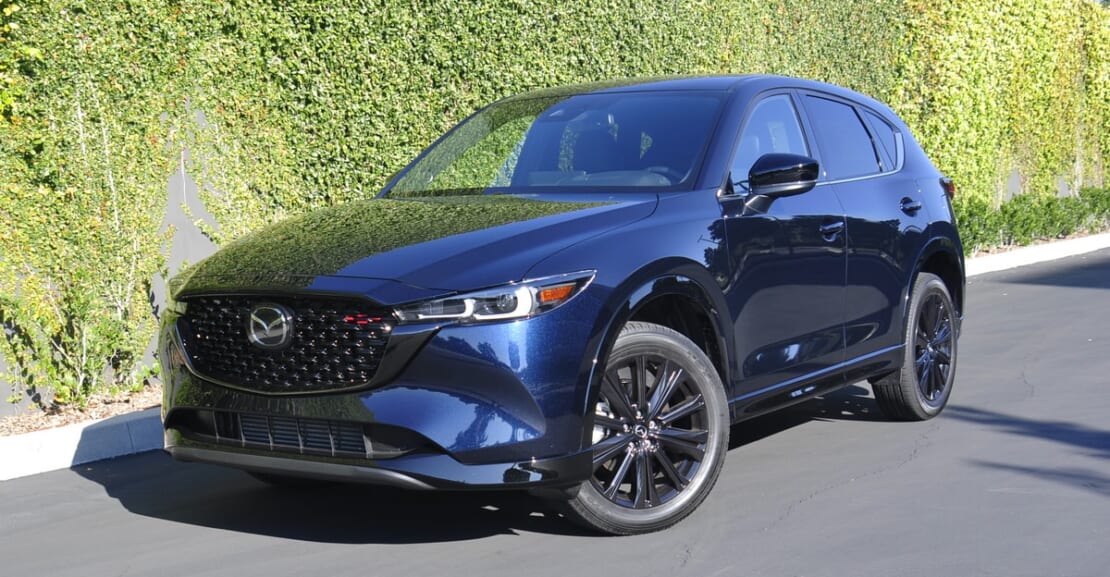Compact SUVs outsell almost every other type of vehicle in America thanks to their great versatility. They can be as easy to drive as compact cars but offer more space. Some can go places no car can because of their all-wheel-drive (AWD) systems, and many are affordable.
The Mazda CX-5 and Honda CR-V are two stalwarts of the class. Let’s see how they compare.
2023 Mazda CX-5
Among mainstream automakers, Mazda is known as the sporty one. It makes great-looking cars that often handle better than the competition. The 2023 Mazda CX-5 is no exception. Sleek good looks, torque vectoring for a sharp cornering feel, and an available turbocharged engine make it one of the best-performing SUVs outside the luxury classes. All-wheel drive is standard. Prices start at $26,700.
Mazda CX-5 Highlights
More affordable: When Honda redesigned the CR-V, they made it look upscale. Then they made the sticker price look upscale, too. The CX-5 has always looked convincingly like a more expensive car without carrying the price tag of one. The base model CR-V costs over $4,500 more than the base model CX-5. Save the money.
Standard AWD: Every CX-5 comes standard with Mazda’s i-Activ AWD system. Only the top-of-the-line CR-V Sport Touring hybrid model comes with AWD out of the box. Power to all four wheels adds $1,500 to the price of every other CR-V trim.
The option of real power: The standard engines of these two are pretty close in power, but each offers an upgrade. Honda’s is tuned for efficiency; it’s a 204-horsepower hybrid setup. Mazda’s can run away from it; it’s a 2.5-liter turbocharged 4-cylinder good for 227 horsepower with regular fuel and 256 with premium.
Check this week’s Fair Purchase Price or see the CX-5 models for sale near you
2023 Honda CR-V

The well-known Honda CR-V has been redesigned for 2023. With new, more rugged looks and hybrid powertrains at upper trim levels, it’s both refined and efficient. Power goes to the front wheels, but AWD is available as an option. Pricing starts at $31,610.
Honda CR-V Highlights
Optional hybrid drivetrain: Mazda is still catching up to the rest of the industry on electrification. The CR-V offers two hybrid trims, with up to 40 mpg in combined driving for front-wheel-drive models. The CX-5 doesn’t offer one.
Class-leading cargo volume: If you’re SUV shopping for the cargo space, the CR-V is probably your pick. Its 76.5 feet, with the rear seats folded, leads the class. The CX-5’s 59.3 is on the smaller side.
Standard Traffic Jam Assist: One of our favorite new features of any 2023 car, Honda’s Traffic Jam Assist works below 45 mph and operates in conjunction with the lane-keeping system, making small steering corrections to keep the CR-V on the right line. It takes over some of the workload in city driving. Impressively, it’s standard on every CR-V, regardless of trim.
Check this week’s Fair Purchase Price or see the CR-V models for sale near you.
Similarities
These are two of the best-looking small SUVs. They carry the same warranty coverage, and their base model engines are just three horsepower apart.
Conclusion
You’d probably be happy with either a Mazda CX-5 or a Honda CR-V. But there are real differences. The CX-5’s standard AWD makes a big difference in the Snow Belt, and its lower price makes a big difference everywhere. The CR-V’s Traffic Jam Assist might be worth the extra money if your daily commute routinely leaves you in bumper-to-bumper traffic. If you only see traffic on TV, you might like the CX-5’s taut handling better.
Either could be a great choice.
Specs
| 2023 Mazda CX-5 | 2023 Honda CR-V | |
| Starting Price | $26,700 | $31,610 |
| Popular Powertrains | ||
| Engine | 2.5-liter 4-cylinder | 1.5-liter turbocharged 4-cylinder |
| Horsepower | 187 hp @ 6,000 rpm | 190 hp @ 6,000 rpm |
| Torque | 186 lb-ft @ 4,000 rpm | 179 lb-ft @ 5,000 rpm |
| Transmission | 6-speed automatic | Continuously Variable Automatic Transmission |
| Fuel Economy | 24 city/30 highway/26 combined (4-cylinder engine) | 28 city/34 highway/30 combined mpg |
| Also Available | 2.5-liter turbocharged 4-cylinder engine w/ 227 horsepower | 2.0-liter hybrid, AWD |
| Specs | ||
| Basic Warranty | 3 years/36,000 miles | 3 years/36,000 miles |
| Powertrain Warranty | 5 years/60,000 miles | 5 years/60,000 miles |
| NHTSA Overall Safety | 5 stars | TBD |
| Max Seating Capacity | 5 | 5 |
| Wheelbase | 106.2 inches | 106.3 inches |
| Overall Length | 180.1 inches | 184.8 inches |
| Width | 72.6 inches | 73.5 inches |
| Height | 65.4 inches | 66.2 inches |
| Turning Diameter | 36.0 feet | 37.3 feet |
| Headroom, Front | 39.7 inches | 38.2 inches |
| Headroom, Rear | 39.0 inches | 38.2 inches |
| Legroom, Front | 41.0 inches | 41.3 inches |
| Legroom, Rear | 39.6 inches | 41.0 inches |
| Shoulder Room, Front | 57.1 inches | 57.9 inches |
| Shoulder Room, Rear | 54.8 inches | 55.9 inches |
| Cargo Volume | 30.8/59.3 cubic feet | 39.3/76.5 cubic feet |
Source link


